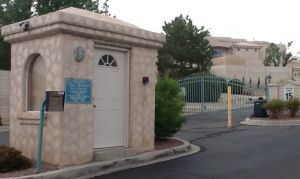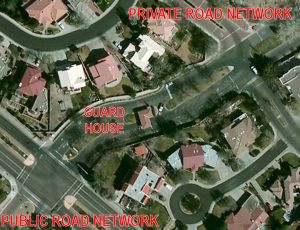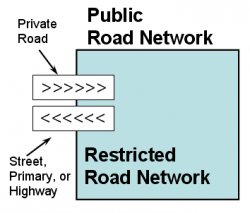Template:ReturnToEditingManual
This page covers the mapping techniques to use for private installations and for neighborhoods that have restricted access of some kind.
Introduction
Definitions



- Private Installation
- A restricted-access set of drivable roads connected at one or more points to a public road network. This could be a gated residential community, an industrial site, a pharmaceutical research campus, a secure government installation, a military base, or any other type of installation with at least one access control point (see gate) or more than one private road. The simplest example is a single private community street protected by a gate. Larger installations might include several types of roads. The largest USA installation is White Sands Missile Range at 3,200 square miles, larger than the USA’s smallest state, and includes dirt roads, primary streets and highways. Large installations might even have smaller private installations inside of them which are closed to most of those who are inside the larger installation.
- Gate
- Any of the points at which the installation connects to the public road network. These might have guarded or card-operated gates, "door buzzers", security cameras, or severe tire damage strips, or simply a sign stating that the road ahead is private or for members, authorized vehicles, etc. Regardless of the physical form, we will refer to these access control points as gates
- Member
- Anyone who can use any of the entrance or exit gates at the installation, including the the more restricted "members only", "residents only", "employees only, "base personnel only", "military ID only" , "authorized personnel only", etc gates (if any) used at the installation.
- Visitor
- Anyone limited to certain entrance and/or exit gates. This could be the pizza delivery driver, the cousin from Peoria, the tourist visiting the air force base to see the military museum, etc.
Routing
Requirements

If both the start and end points are outside the installation (points A and B in figure 1), Waze must not choose a route through the installations route around the private installation from A to B even though a shorter or faster route might exist through the two access points of the installation. Waze must also be able to route from A a to C (where C is inside) or C to A, making the optimum choice of entrance or exit gate.

Figure 2 shows a more complex private installation with another nested inside it -- and another nested inside that. A route inside the installation, as from A to B, does not pass through any of the nested installations. A route from the deepest level to or from the public roads, as between C and D, takes advantage of the optimum gate. And the route between different levels, as between E and F, does not involve any layers it doesn't need to visit.
Waze should be able to take advantage of the characteristics of different road types and avoid dirt roads if the wazer requests it. Finally, Waze must not throw map errors when members drive through member-only entrances and exits. This means these entrances must not be disconnected or prohibited by red arrows or --->time based restrictions.<--- can violation OT time based cross-segment restrictions cause map problems?
Approach
Waze does not know who is a visitor and who is a guest, so we can't get Waze to give different directions for each. Instead, we will get Waze to give the best possible routes for visitors, and prevent Waze from telling anyone to take short cuts through gated communities and military bases. Wazers can get good routes within the installation, and routes out through the best choice of the visitor gates. Wazers who want to go in or out the member gates can "add a stop" to their navigation at the gate they prefer. This is the best Waze map editors can do with the tools currently available.
To make this work, editors must focus on the access points or gates, and control access by using the correct "recipe" for each type of gate. Inside the installation, every type of road can be used where appropriate. Do not make all the roads private inside the installation.
The six types of gates can be divided into two classes -- simple and everything else. For the simplest type of installation, where there is only one exit, a simple gate will works. For any installation that has more than one exit, the simple gate will cause strange routing out of the installation -- we don't know why -- and the other types of gates must be used. Never mix the simple gate with the other types of gates in the same installation.
Underlying logic
The current approach to constructing gates takes advantage of the Waze routing penalty system to control driving directions. For every route that includes private segments, Waze imposes a penalty each time the route goes from from' a Private segment to any other road type. This causes Waze to avoid driving through a private segment to get to the street on the other side, even if it has to find a longer and more time-consuming route to get there. Because of this, Waze editors can use private segments at private installation gates to prevent Waze from giving routes that short-cut through private installations.
Gate recipes
All house numbers inside the installation should be applied inside the gates, not on any of the gate segments. All the segments used in gate recipes must be at least 19.69 ft (6 m) long.
- Simple Gate -- one 2-way private road segment. If a point is used to mark the gate, place it in the middle of the segment. Do. OT mix simple gates with any other type of gate in the same installation.
- Visitor Entrance -- one one-way private road segment heading into the installation. If a point place is used, place it in the middle of the private segment.
- Visitor Exit -- (nothing) no private segment is needed. Use the same road type as the rest of the road the gate is on.
- Member Entrance -- Three one-way segments, headed into the installation, in this order: private, street, private. If a point place is used to mark the gate, place it in the middle of the innermost private segment.
- Member Exit -- one one-way private segment. If a point place is used to mark the gate, place it in the middle of the private segment.
- Member 2-way gate -- Three 2-way segments, in this order: private, street, private. If a point place is used to mark the gate, place it in the middle of the middle (street) segment.
Simple Installations
If there is only a single entrance/exit, a simple gate can be used. If there is more than one exit or entrance, using simple gates can cause Waze to create non-optimum routes out of the installation.
All other Installations
If there is more than one entrance or exit, do not use any simple gates. Instead, select from the other types of gates.

Nested Private Installations
When one private installation is located inside another, simply follow the same rules to construct all the gates for the smaller installation within the larger.
Gate Closures and Restrictions
Sometimes visitor or member gates are closed at certain times of day, days of week, or on specific dates. Use Scheduled Restrictions to "close" the affected gate. Apply the restriction to just one segment. For a visitor entrance, apply it to the private segment. For a member entrance, apply it to the inner-most private segment. For a member entrance, apply it to the private segment. For a visitor exit, apply it to the segment that runs through the physical location of the visitor exit gate. Often, the same restrictions apply to an entry and exit located right next to each other. You can find the hours of gates or entry points through the private installation website or by calling the appropriate private installation authority.
Route Testing
These guidelines have been tested on actual private installations of various types and discussed in the Waze Forum. You may wish to test your own edits. Here are some suggestions of how you may accomplish this after your edits have been uploaded to the routing servers.
- Monitor that area for User Reports.
- Test drive.
- Navigate between two distant points outside the private installation to ensure no through-routing.
- Navigate from outside to inside the private installation, drive around the outside of the private installation and ensure rerouting occurs to the logical nearest gate.
- If you have access to the private installation, repeat the above, by by driving around inside the installation.
- Test routes in Live Map to ensure no through-routing and good on/off installation routing.
- Test routes in client by setting various "from" and "to" destinations without having to drive.
Other features
Places / City Names for Private Installations
Should a private installation be marked over it's entire area as a Place Area (old landmark)? Not always. Very small private installations are usually marked by a Area Place over their entire area. This does not make sense for larger private installations that might have other Places within them or that are actually cities. For these larger installations, use the city field of all street names to name the private installation.
In general here is specific guidance about Private Installations use of Places or City Names:
- Does the state DOT consider it a city? If so, then use City Names in each street to identify the installation.
- Does the US Post Office consider it a city with it's own zip code? If so, then use City Names.
- Does the local community consider it a city like entity? Then maybe it should have a City Name if it is large, or an Area Place if it is small.
- Is it large enough that an overall Area Place on the Private Installation would obscure finer detail Area Places below? If so, use City Names. If not, use an Area Place to denote the Private Installation.
What smaller Place should be included within a larger private installation? We should generally follow the rules that are set for Places in cities and areas. In addition to these, you might also consider marking the following as Places because they are critical navigation and destination points:
- Entry/Exit gates (Place Area)
- Visitor Centers (Place Area)
- Museums and other similar destinations the installation may maintain
- Memorials
- Parade Fields
- Items locally useful for navigation
You should avoid mapping Places that are specific to private or military uses on a private installation. See the Places Wiki Page for specifics about using an Area or Point for these items.
Military Bases and Government Installations
While road treatment is covered in the body of this Wiki page, questions often arise about what items to landmark by adding Area and Point Places on these facilities. This is particularly important if you have access to these locations as a resident, worker, or visitor and use that access to learn something about the Private Installation. A general rule is to not mark specific locations with a Place unless the it his is already public information found on road maps or the installation's public website, in maps or directories. Secure installations often do not provide information about hangar numbers, building numbers, organizational names.
Landmarks (Places) approved for military bases
- Commissary
- PX/BX
- Gas stations
- Parks
- Museums
- Visitor Gates
Parking Lots
Paid parking lots and other parking facilities are to be mapped with parking lot roads, and not according to the Private Installation rules defined in this article. See Best map editing practice#Parking Lots.
Theme Parks
Publicly accessible roads in a theme park, even after a pay-station/gate, are to be mapped with parking lot roads, similarly to other paid parking lots. Furthermore, be careful with mapping the "backstage" private roads which are only to be used by employees. It may be wise to not map these roads, similarly to "air-side" airport roads as described below (but to a lesser extent), so that routes are given to the public entrance of the theme park facility.
Airports
Do not map the private, restricted-access roads on airport grounds at all. Map airport roads which are accessible to the public (terminal pick-up/drop-off roads, parking lot access roads, etc.) as public roads, not as private installations.
Airports have "air-side" restricted road networks that allow traffic for baggage carts, service vehicles, airplane fuel tankers, etc. While it may be tempting to map this road network either as an isolated set of roads or with provisions cited elsewhere in this document for Private Installations, this should not be done. Here's why:
- A large number of people use Waze to navigate to airports. The particular search service or function that returns a GPS coordinate to Waze may be in error, placing the destination marker nearer to the air-side private road network of the airport than to the public airport roads. This could lead to an incorrect route or even an impossible-to-reach destination, which would frustrate the traveler.
- The private air-side road network of an airport tends to be both close to and accessible from the public road networks around the airport and therefore is more prone to this navigation error.
- Very few people use the private road network of an airport, relative to the great number that use an airport's public access roads. To those that have requested this function, we apologize. The benefit of doing this for few would likely inconvenience many. We suggest routing to the nearest spot to your destination (i.e., the gate) on the public road network.
In some cases, military bases hold public airports. In such situations, some discretion and creativity may be needed to decide which roads on the airport should not be mapped and which on the military base should be mapped. Usually there is a second perimeter around the airport separating it from the base.
